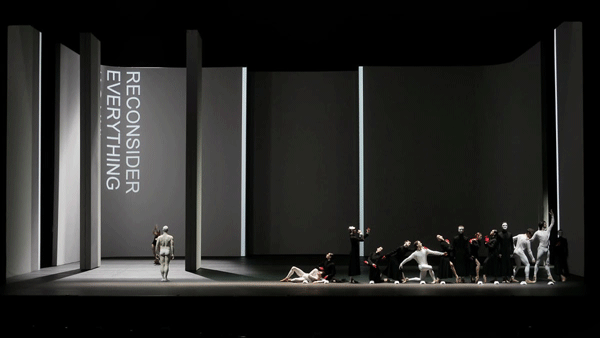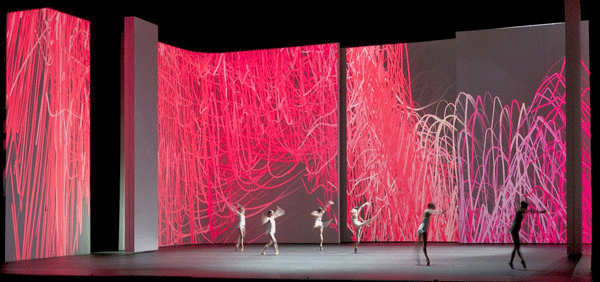Typifying a new generation of artists who can move seamlessly between high technology and traditional media, Berliner Eno Henze has established a reputation for his innovative and original work in design, scenography and fine art. I caught up with him ahead of his appearance at Alpha-ville EXCHANGE on 17 January 2014 in London, to talk a little about his creative processes and the places, people and art that inspire him.
DW: Hi Eno, pleasure to meet you. Between talking at Resonate in Belgrade, working with the choreographer David Dawson for both the English and Dutch National Ballets and curating NODE13 at Frankfurter Kunstverein, 2013 must have been a very busy year for you! What have been your personal highlights? What were you most excited to be working on?
EH: Producing work for stages with a long history and a classical repertory is the biggest challenge for me. The traditional framing forces you to precisely place your work in an art historical context, which is something that often tends to be forgotten in contemporary art that uses new media. On the other hand, the limitations in time, budget and space really push you into focussing your ideas down to the core where it’s most relevant. In this regard I think the work Overture for the Dutch national ballet has been the most inventive and audacious piece of mine this year. A very complex, yet simple looking kinetic light sculpture divides the stage into different proportions and creates a technological choreography that relates to the dancers.

DW: Your work spans set design, installations and drawings and uses a range of media from lasers to pushpins. What would you say are your main sources of inspiration, and how do you go about making new work?
EH: A lot of my work examines the relationship between humans and technology. This is due to a weird techno love that I share with the society, and in which I would love to indulge myself unscrupulously… Yet, somehow I’m suspicious of technologies promises, and I wonder whereabouts in all that mechanic, generative, algorithmic movement the human might keep its place. So I’m not really limited in the type of media, which is very much defined by the particular application, but I am looking for contemporary processes that employ both human and machine intelligence. Sometimes this leads to very manual executions, as it was the case in the pushpin paintings.
DW: A lot of the most innovative work in generative art and design is coming out of Berlin at the moment. I’m thinking of your Ambush series and of the work of the design studio Onformative, who will be speaking alongside you at Alpha-ville EXCHANGE on 17 January in London. What do you think it is about Berlin that has inspired this generation of digital artists?
EH: I think it’s very simple. In comparison to any other European capital living in Berlin is extremely affordable. This creates a huge surplus in time and space and attracts a lot of creative people. Some of them must be very good. This is not limited to generative design, but stretches across artists from all disciplines. The lack of restrictive forces is also dangerous, though, it leads to a lot of unfinished, unprecise stuff you think you can finish tomorrow. Limitations are very helpful sometimes, and I’m thus always inspired by the buzz of London. It gives me a break from Berlin slackers.

DW: You’ve been instrumental in curating the NODE symposia, a series of events for the exchange of ideas about digital art. What opportunities, do you think, can arise when creative practitioners come together to share their work at events like NODE and Alpha-ville EXCHANGE?
EH: We circulate a lot of images and are very much used to browsing visually. Opportunities like Alpha-ville EXCHANGE, NODE or Resonate help conceptualize work and form the idea of a movement. There we create a theoretical subtext to the visible surface, and negotiate what’s important for future development. If the mix is alright it’s possible to make new steps, and infuse your own work with new concepts.
DW: Is there anyone on the bill at Alpha-ville EXCHANGE who you are particularly excited to see?
EH: I have been in touch with Davide Quayola only digitally, and I really look forward to meeting him in person. I admire how he collides classical sculptures with the digital, and builds his work on historical ground.
DW: You have a history of using high-technology and taking part in interesting collaborations. What are your plans for the future?
EH: Apart from working on a new set design for Tristan and Isolde, I’ll go into a studio retreat to develop new work and do research. I have a visit to CERN planned.
DW: Good luck with that! One final question, what can we expect from your presentation at Alpha-ville EXCHANGE on Friday 17th?
EH: My presentation at EXCHANGE will show why man is unthinkable without machine, and how that affects the production of art today.
DW: Thank you, Eno.
Catch Eno Henze at Alpha-ville EXCHANGE on 17 January 2014 at London’s Rich Mix, when he will join a diverse line-up of international artists and creative practitioners in exploring the intersection of art, technology and society. Get your tickets via Eventbrite.
Image Credits:
Image 1: Red Ambush
Image 2 and 3: Timelapse/(Mnemosyne). Concept and Staging David Dawson. Set Design Eno Henze
